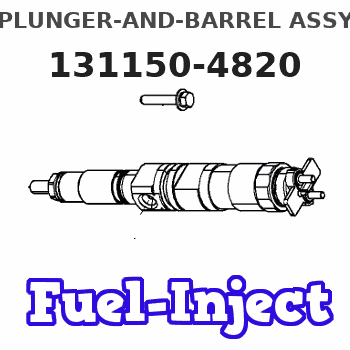Information plunger-and-barrel assy
BOSCH
9 413 614 302
9413614302
ZEXEL
131150-4820
1311504820

Rating:
Compare Prices: .
As an associate, we earn commssions on qualifying purchases through the links below
6PCS XDEP Fuel Injection Pump AD-Type Plunger Element and Barrel Assembly 131150-4820 A836
XDEP Part Number: 131150-4820 A836 || Application: Diesel Fuel Injection System, Plunger Replace for Pump || Guarantee: 100% Tested Before Shipping to Ensure Product Safety, Stability and Durability || Function: High-Quality Material for Long-Lasting Durability, Perfect Match for the Pump and Easy to Install || TIPS: Please be sure to compare carefully with photos and check part number before buying items, If you are not sure this part is suitable, please feel free to contact us, we'll reply you as
XDEP Part Number: 131150-4820 A836 || Application: Diesel Fuel Injection System, Plunger Replace for Pump || Guarantee: 100% Tested Before Shipping to Ensure Product Safety, Stability and Durability || Function: High-Quality Material for Long-Lasting Durability, Perfect Match for the Pump and Easy to Install || TIPS: Please be sure to compare carefully with photos and check part number before buying items, If you are not sure this part is suitable, please feel free to contact us, we'll reply you as
4PCS Diesel Injector Plunger 131150-3920 131150-4320 131150-4420 131150-4820 105990-51100 105700-51100 - (Color: 4PCS 131150-4820)
Generic Color: 4PCS 131150-4820
Generic Color: 4PCS 131150-4820
You can express buy:
USD 97.93
14-06-2025
14-06-2025
131150-4820 CP800033 154200-6920 9421620901-3 131160-4620 For E320C/D S6K Engine Diesel Pump Repair Kit Fuel Injector Copper Set
Images:
USD 53.31

[26-Jun-2025]
USD 8.13

[24-Jun-2019]
Include in ###:
Number on scheme 30


1010404080
as PLUNGER-AND-BARREL ASSY
1010404120
as PLUNGER-AND-BARREL ASSY
A836
1010404160
as PLUNGER-AND-BARREL ASSY
1010628520
as PLUNGER-AND-BARREL ASSY
A836
1010628570
as PLUNGER-AND-BARREL ASSY
Cross reference number
Zexel num
Bosch num
Firm num
Name
131150-4820
9 413 614 302
PLUNGER-AND-BARREL ASSY
C 14EM PLUNGER ASSY PL(AD) PL
C 14EM PLUNGER ASSY PL(AD) PL
Information:
Typical 12 Volt Starting Circuit
(1) Test point. (2) Test point. (3) Test Point. (4) Test Point. (5) Test Point. (X) Hold-in coil. (W) Pull-in coil.General Information
All starting systems are made up of four elements. They are the ignition switch, start relay, the starting motor solenoid and starting motor. The only exception to this is that on some small engines the start relay may not be required. In this case, the start switch powers the starting motor solenoid directly.Start switches are relatively low current devices. They are rated to switch approximately 5 to 20 amps. Because the coil of a start relay [between test point (1) and (2)] draws about 1 amp, the start switch can easily turn on the start relay and have long life.The switch contacts of a typical start relay are rated to switch between 100 and 300 amps. Because the solenoid requires 5 to 50 amps, the start relay can easily switch this load.The starting motor solenoid has two functions: 1) it engages the pinion with the flywheel, and 2) it is a high current switch rated about 1000 amps that actually turns on the starting motor.The starting motor solenoid has two coils. Pull-in coil (W) draws about 40 amps and hold-in coil (X) requires about 5 amps. The instant the start relay closes, both coils (W) and (X) receive power. Battery voltage is applied to the high end of both coils, at test point (3) which is the start (S) terminal. The low end of hold-in coil (X) is permanently grounded to the ground post or motor housing of the starting motor. Grounding for the low end, test point (4), of pull-in coil (W) is momentary, and takes place through the DC resistance of the starting motor. As soon as magnetic force builds in both coils, the pinion moves toward the flywheel ring gear. The pinion will stop short of engagement of the flywheel ring gear. Only then will the solenoid contacts close to power the starting motor. This temporarily removes the ground from pull-in coil (W), and puts battery voltage on both ends of it while the starting motor cranks. During this period, the pull-in coil is out of the circuit. Cranking continues until power to the solenoid is broken by releasing the ignition switch.The result of these switches and relays is to permit a 5 amp dash-mounted switch to turn on a 500 to 1000 amp motor used to crank an engine.Battery voltage (power) available during cranking varies according to the temperature of the batteries. The following chart is a guide as to what to expect from a normal system. The next chart shows maximum acceptable voltage loss in the high current battery circuit feeding the starting motor. These values are maximums for machines of approximately 2000 SMH and up. Newer machines would be less than those shown. Voltages greater than those shown are most often caused by loose and/or corroded connections or defective switch contacts.Diagnosis Procedure
Do not operate the starting motor
Have questions with 131150-4820?
Group cross 131150-4820 ZEXEL
131150-4820
9 413 614 302
PLUNGER-AND-BARREL ASSY




